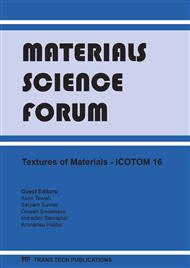[1]
N. Tsuji, Y. Ito, Y. Saito, Y. Minamono, Strength and ductility of ultrafine grained aluminum and iron produced by ARB and annealing, Scripta Mater. 47 (2002) 893-896.
DOI: 10.1016/s1359-6462(02)00282-8
Google Scholar
[2]
Y. Saito, H. Utsunomiya, T. Sakai, Novel ultra-high straining process for bulk materials development of the accumulative roll-bonding (ARB) process, Acta Mater. 47 (1999) 579-583.
DOI: 10.1016/s1359-6454(98)00365-6
Google Scholar
[3]
N. Rangaraju, T. Raghuram, B. V. Krishna, K. P. Rao, P. Venugopal, Effect of cryo-rolling and annealing on microstructure and properties of commercially pure aluminium, Materials Science and Engineering A 398 (2005) 246–251.
DOI: 10.1016/j.msea.2005.03.026
Google Scholar
[4]
V. S. Sarma, J. Wang, W.W. Jian , A. Kauffmann, H. Conrad, J. Freudenberger, Y.T. Zhu, Role of stacking fault energy in strengthening due to cryo-deformation of FCC metals, Materials Science and Engineering A 527 (2010) 7624–7630.
DOI: 10.1016/j.msea.2010.08.015
Google Scholar
[5]
T. Konkova, S. Mironov, A. Korznikov, S.L. Semiatin, Microstructural response of pure copper to cryogenic rolling, Acta Materialia 58 (2010) 5262–5273.
DOI: 10.1016/j.actamat.2010.05.056
Google Scholar
[6]
T. L. Brown, C. Saldana, T. G. Murthy, J. B. Mann, Y. Guo, L. F. Allard, A. H. King, W. D. Compton, K. P. Trumble, S. Chandrasekar, A study of the interactive effects of strain, strain rate and temperature in severe plastic deformation of copper, Acta Materialia, 57 (2009) 5491–5500.
DOI: 10.1016/j.actamat.2009.07.052
Google Scholar
[7]
Y. B. Lee, D. HyukShin, K.T. Park, W. J. Nam, Effect of annealing temperature on microstructures and mechanical properties of a 5083 Al alloy deformed at cryogenic temperature, Scripta Materialia 51 (2004) 355–359.
DOI: 10.1016/j.scriptamat.2004.02.037
Google Scholar
[8]
D. Das, A. Samanta, P. P. Chattopadhyay, Deformation Behavior of Bulk Ultrafine Grained Copper Prepared by Sub- Zero Rolling and Controlled Recrystallization, Materials and Manufacturing Processes 21 (2006) 698–702.
DOI: 10.1080/10426910600613504
Google Scholar
[9]
R. J. Asaro, S. Suresh, Mechanistic models for the activation volume and rate sensitivity in metals with nanocrystalline grains and nano-scale twins, Acta Materialia 53 (2005) 3369–3382.
DOI: 10.1016/j.actamat.2005.03.047
Google Scholar


